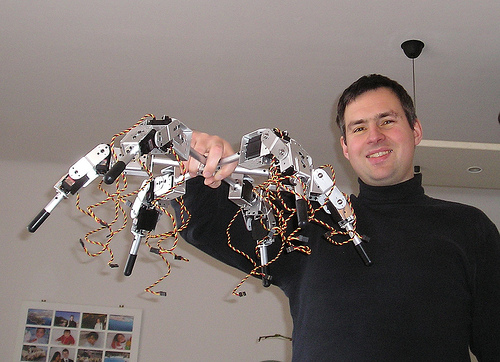The premise of this book is that otherwise good (or at least not actively bad)
people can do bad, indeed evil things and that this can be explained by the
situation in which the acts took place. In 1971 Zimbardo conducted the
“Stanford prison experiment” in which students enacted the roles of prison
guards and prisoners - the results so traumatised Zimbardo that supposedly he
never gave the experiment the complete write-up he intended to. Many years
later he acted as an expert witness for the defense of one of the soldiers in
the Abu Ghraib prisoner abuse scandal. It was this experience and his
frustration with organisations who still explain wrongdoing as being the work
of a “few bad apples” rather than a “bad system” that caused him to write this
book.
Just under half the book (chapters 2-9, 192 pages) is a description of the
Stanford Prison Experiment, followed by another two chapters of reflection on
the events during the experiment. There is now a website dedicated to the
Stanford Prison Experiment at prisonexp.org so I won’t
give a detailed summary of the experiment here. Suffice it to say that from a
group of young male volunteers some were chosen at random to act as prison
guards and the rest to act as prisoners in a pretend prison in the psychology
department basement. The experiment had been due to last two weeks but
Zimbardo abandoned it on the tenth day because of the worsening treatment of
the “prisoners” by the “guards.”
Chapters 12 (Investigating Social Dynamics: Power, Conformity and Obedience)
and 13 (Investigating Social Dynamics: Deindividuation, Dehumanisation and the
Evil of Inaction) are the most interesting chapters as they give several short
summaries of various experiments and events that show how people can be
persuaded to do things that they would normally insist that they would never
do.
Chapter 14 describes Zimbardo’s experience as an expert witness at the court
martial of one of the soldiers involved in the Abu Ghraib prisoner abuse
scandal.
Chapter 15 describes the systemic elements that Zimbardo feels are the root
causes of Abu Ghraib prisoner abuse.
Finally chapter 16 gives some case studies of heroes who have resisted
systemic forces such as Hugh Thompson who confronted superior officers and
forced (using the guns on his helicopter) them to halt the My Lai massacre in
Vietnam and Joe Darby who blew the whistle on the prisoner abuse at Abu
Ghraib. Chapter 16 also gives some pointers on how people can resists
situational forces and avoid drifting into committing evil acts.
I think one problem with this book is that the Stanford Prison Experiment is
presented in such detail - half the book (if the two post-mortem chapters are
included) is devoted to the experiment and yet of all the cases mentioned in
the book it is perhaps the least interesting - the shorter case studies get to
the point quicker, Abu Ghraib is more notorious and others such as the Rwandan
genocide are more horrifying. I feel that Zimbardo felt that he had to give
detail on the Stanford Prison Experiment to back up some of his claims and yet
by including all that detail he makes the book less interesting overall. The
Stanford experiment is also the one that Zimbardo has the most personal
experience with.
However, despite find the overlong description of the Stanford experiment
somewhat sleep inducing in places the book is genuinely interesting and
chapters 12, 13 and 16 do go a long way to explaining why people do evil
things and how people could better resist being caught up in a situation and
led to do evil.
In chapter 12, Zimbardo quotes from C.S. Lewis and I’m going to reproduce the
quote below since I agree with Zimbardo that it perfectly summarises how
social presures can cause people to do things that are not in accordance with
their own ethical beliefs.
To nine of ten of you the choice which could lead to scoundrelism will come,
when it does come, in no very dramatic colours. Obviously bad men, obviously
threatening or bribing, will almost certainly not appear. Over a drink or cup
of coffee, disguised as a triviality and sandwiched between two jokes, from
the lips of a man, or woman, whom you have recently been getting to know
rather better and whom you hope to know better still - just at the moment when
you are most anxious not to appear crude, naive or a prig - the hint will
come. It will be the hint of something, something that the public, the
ignorant, romantic public, would never understand. Something which even the
outsiders in your own profession are apt to make a fuss about, but something,
says your new friend, which “we” - and at the word “we” you try not to blush
for mere pleasure - something “we always do.” And you will be drawn in, if you
are drawn in, not by desire for gain or ease, but simply because at that
moment when the cup was so near to your lips, you cannot bear to be thrust
back again into the cold outer world. It would be so terrible to see the other
man’s face - that genial, confidential, delightfully sophisticated face - turn
suddently cold and contemptuous, to know that you had been tried for the Inner
Ring and rejected. And then, if you are drawn in, next week it will be
something a little further from the rules, and next year something further
still, but all in the jolliest, friendliest spirit. It may end in a crash, a
scandal, and penal servitude; it may end in millions, a peerage and giving the
prizes at your old school. But you will be a scoundrel.
Case studies in chapter 12 include well know classics such as the Milgram
experiments in which subjects believed that they were giving lethal electric
shocks and yet still went ahead and pressed the button. Other examples include
the “strip search scam” in which someone impersonating a police officer phones
the assistant manager of a fast food restaurant with the news that one of his
young female employees has been involved in some criminal activity such as
shoplifting or selling drugs. The imposter says that he, and other police
officers, are on the way and suceeds in persuading the manager to isolate the
employee in a room and then, over the phone, persuades the employee to submit
to a strip search conducted by the manager. This escalates from a simple
search to performing various degrading acts such as perforning oral sex with
another older male employee. This might sound like a one-off incident but
Zimbardo reveals that this scam was perpetrated 68 times, in 32 different
states, half a dozen different fast-food chains and with both male and female
assistant managers. Zimbardo quotes socialogist EsterReiter who states that
the most valued trait in fast-food workers is obedience to authority and a
retired FBI agent who says the following:
You and I can sit here and judge these people and say they were blooming
idiots. But they aren’t trained to use common sense. They are trained to say
and think, “Can I help you?”
Another example was of a woman being attacked who manages to temporarily
escape and rush naked into the street where she is seen by a crowd of people
and yet her attacker is able to recapture and drag her back inside where he
rapes and murders her without anyone intervening. Situations like this seem
completely insane - given the large number of witnesses one would think that
at least someone would be driven to act and save the poor woman from her fate.
However, it seems that the larger the number of onlookers the less likely help
is to arrive because people are more likely to act like the majority (ie do
nothing).
Chapter 13 discusses the roles of deindividuation and dehumanisation - in
other words the less known about an individual or group and the more they are
made to seem less than human the easier it will be to persuade someone to
commit an evil act upon that individual or group.
In summary, I did learn something from this book about powerful and insidious
situational forces could be in persuading people to act against their better
natures. I do feel though that too much time was given to the Stanford Prison
Experiment and that the book would have benefited if the text on the Stanford
experment had been cut by half and the space gained used to expand on the
material in chapters 12, 13 and 16.
Links








